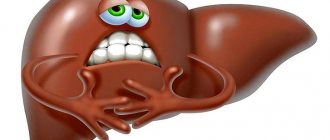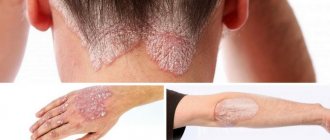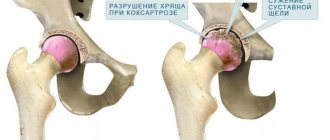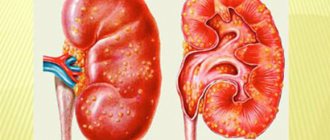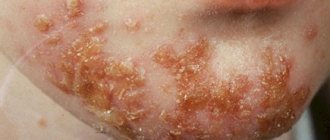A little about the disease
Hypertrophic gingivitis can be an independent pathology or appear for the first time during an exacerbation of periodontitis.
Many patients confuse these two diseases due to the similarity of symptoms - bleeding gums, swelling of soft tissues and pain. Moreover, unlike periodontitis, gingivitis has an acute inflammatory nature. Due to ignoring the acute process and failure to take timely therapeutic measures, the volume of periodontal tissue begins to increase sharply. However, the dental epithelial junction remains intact, bone tissue is not involved in the pathological process, and inflammation affects only the upper layer of the gum epithelium. With periodontitis, the clinical picture is different - inflammation first develops in the superficial layers of the gingival epithelium, then affects the lower layers and reaches the bone tissue, leading to loosening and loss of even healthy molars.
The main danger of inflammatory hypertrophy is considered to be the transition to periodontitis, in which the patient may lose one or more teeth, even if they outwardly look absolutely healthy. When the gum tissue becomes inflamed, it swells, forming pockets around the molars, which over time become filled with bacterial plaque. At first its consistency is soft, then the plaque hardens, which leads to exposure of the cervical areas of the teeth. Gums react violently to sweet, sour, hot or too cold foods.
It becomes impossible to fully treat the oral cavity in order to get rid of 100% of bacterial plaque due to pain during brushing and due to the increase in the rate of reproduction of pathogenic microorganisms. That is why at this stage it is important to consult a dentist in order to diagnose the initial stage of the problem in time, cleanse the oral cavity of plaque and tartar, and reduce the risk of gingivitis turning into periodontitis.
Gingivitis in children
It usually occurs due to the development of stomatitis, during teething, or when a primary dentition changes to a permanent one.
Localized gingivitis can be caused by trauma to the gums when children chew on toys. In adolescence, the disease can occur due to an imbalance of hormones during puberty; in girls, exacerbations can occur during menstruation.
Gingivitis is also observed when immunity is weakened, after severe infections or exacerbation of chronic pathology.
Children with gingivitis most often develop bleeding gums due to stomatitis, teething or changing teeth, which does not bother them at all. In adolescents, gingivitis manifests itself in the form of bleeding, loose gums, an increase in their volume and gum growth in the area of the front teeth. Teenage gingivitis is difficult to treat and can cause bad breath.
We invite you to familiarize yourself with Pulpit
In adults, gingivitis is painless; bleeding gums occur when biting into dense food or brushing teeth; there may be bad breath and a taste in the mouth. The gums may become swollen and red.
The ulcerative form is manifested by the formation of erosions and ulcers, characterized by pain and putrid odor from the mouth, the gums bleed even with light pressure.
Gingivitis is treated by a dentist after identifying its underlying cause.
If the cause is poor oral hygiene and the formation of tartar and plaque, professional oral cleaning is performed in a doctor's office. Tartar and hard plaque are removed. Then the teeth are polished using special abrasive pastes, this prevents repeated deposits of tartar.
In case of bleeding and inflammation of the gums, they are treated with antiseptics and medications are applied, and rinses with antiseptic solutions are used. In case of severe inflammation, anti-inflammatory drugs are prescribed. After the inflammation is relieved, the doctor selects the right hygiene products - toothpaste, brush and dental floss.
Treatment of gingivitis in children is carried out by eliminating stomatitis, using means to facilitate teething and treating the oral cavity with antiseptic solutions.
During pregnancy, gingivitis is treated with applications of decoctions of medicinal herbs, rinsing the mouth with antiseptic solutions, and taking vitamins and minerals. In the dentist's office, teeth are cleaned to remove plaque and tartar.
Etiology of hypertrophic gingivitis
The causes of gum hypertrophy can be both general and local, but more often they are a combination. The main place is given to hormonal disorders. hypertrophic juvenile gingivitis and pregnancy gingivitis as independent forms is not very convincing, since it is not youth or pregnancy itself that causes gingivitis, but the corresponding local metabolic changes under the influence of endocrine changes during these periods with the obligatory presence of microbial accumulations. A role is played by hereditary predisposition, side effects of certain drugs used to treat epilepsy (phenytoin (diphenin), succinimide, depakine, etc.), immunosuppressants (cyclosporine), as well as calcium channel blockers - in severe hypertension or heart disease (nifedipine, diltiazem ).
Anomalies in the development of the dental system (deep bite, deep incisal overlap, crowded teeth, mouth breathing, etc.) can be local factors in the development of hypertrophic gingivitis.
Focal hypertrophic gingivitis can occur with prolonged mechanical trauma to the gums, in the presence of overhanging edges of fillings and artificial crowns, and cervical carious cavities. In these cases, the proliferative process develops as a consequence of the action of a small stimulus over a long period of time.
Hypertrophic gingivitis , like ulcerative gingivitis, is usually preceded by chronic catarrhal gingivitis. Under the influence of the factors listed above, inflammation in the gums becomes chronic. The morphological picture of the disease is dominated by proliferation processes.
Herbal rinses and infusions
You can prepare them yourself.
Herbs such as eucalyptus, sage, and chamomile are used for mouth rinses. But it’s worth considering that homemade solutions will contain a high amount of pigments that stick to the teeth very quickly. As a result, a film will appear on them, on which various microorganisms can easily settle, and as a result, the amount of plaque and tartar will increase. Instead of herbal decoctions prepared at home, both the solutions described above and special elixirs containing plant extracts can be used, but do not have pigments, and therefore are safe for teeth. They can be used throughout the year, but such an elixir should not contain any antibacterial additives (for example, triclosan). What else can you use to rinse your gums?
In case of inflammation of the gums, antiseptic rinses act as an auxiliary remedy; under no circumstances can they be used for independent treatment of the disease.
In addition, you should not rinse your mouth with an antiseptic such as hydrogen peroxide. Treatment with its help can only be carried out at an appointment with a doctor as part of complex therapy. Peroxide is used to rinse periodontal pockets. To do this, you need to draw it into a syringe, break off the sharp end of the needle and insert the blunt edge into the periodontal pocket, rinsing it under pressure.
Causes of the hypertrophic process
Chronic hypertrophic gingivitis - this diagnosis is made to almost all patients who consult a doctor with signs of an inflammatory process and proliferation of epithelial tissue. After all, cell division of the gum mucosa does not begin overnight; the process can take months and years before the tissue begins to partially cover the crown of the teeth.
It is a long and practically asymptomatic course (and more often ignoring obvious signs of inflammation) that provokes the transition of the disease to a chronic form. Advanced gingivitis occurs as a result of acute carious processes in the oral cavity, untimely visit to the dentist with severe symptoms of gum inflammation, as well as the rapid and constant proliferation of bacterial flora in the oral cavity.
If the patient also neglects the rules of good hygiene (does not brush teeth twice a day, does not use mouthwash and dental floss), the consequences can be disastrous, including surgical intervention. No less often, and even more often than the accumulation of bacterial plaque in the oral cavity, the cause of gingivitis is mechanical trauma to the gums, the following factors lead to it:
Gingivitis during pregnancy
- poorly selected and installed prosthesis;
- an error when installing a bracket system, when part of the metal arch or the plates themselves regularly injure the mucous tissue;
- contact of the filling material with the gum tissue and irritation of the mucous membrane as a result of inaccurate filling or the release of parts and material beyond the root apex;
- abnormal bite;
- accumulation of tartar that has not been removed from the surface of the molars for many years.
Some patients who are diagnosed with gum hypertrophy wonder why this happened, because they regularly underwent examination and treatment by the dentist, and also fully observed oral hygiene. The root of the problem in such situations may be hidden in a completely different place, at first glance, absolutely unrelated to dental diseases - these are concomitant pathologies that provoke the division of epithelial cells of the gums:
- diabetes mellitus, diseases of the endocrine system, thyroid gland;
- the presence of malignant neoplasms in the body;
- problems with the gastrointestinal tract - gastritis, gastroesophageal reflux, peptic ulcer;
- pathologies of the heart and blood vessels;
- insufficient intake of vitamins A, B, K, P and C into the body;
- recurrent diseases of the upper respiratory tract - tonsillitis, sinusitis, bronchitis, pneumonia.
This is interesting: Periostitis: causes of inflammation in the upper jaw, symptoms, differential diagnosis and treatment methods
In children, hypertrophic gingivitis is practically not diagnosed, since parents teach the child to practice independent oral hygiene, and if caries, stomatitis and other pathologies develop, they immediately take him to the doctor .
Another thing is juvenile gingivitis, it occurs not so much due to inadequate oral care and mechanical injuries to the mucous membrane, but due to hormonal changes in the body. Read also: Gum diseases
If a lack of vitamins is simultaneously added to this problem, these factors have a detrimental effect not only on the internal organs and development of the body, but also on the condition of the gums, leading to hypertrophy. The same symptoms are often observed in women during pregnancy, as well as against the background of sharp hormonal surges and a lack of beneficial microelements.
Rare causes
- diabetes mellitus and various types of disorders in the endocrine system;
- the presence of malignant tumors in the body;
- infectious diseases of the respiratory tract;
- diseases of the gastrointestinal tract;
- problems with the cardiovascular and nervous systems;
- chronic vitamin deficiency.
Rarely, in dental practice there have also been cases where mucosal hypertrophy occurred as a result of pregnancy. The fact is that during this period women experience a sharp change in hormonal levels. If, in addition to the whole body, you also have to experience an acute shortage of useful microelements, then this may not have the best effect on the condition of the oral cavity in general and on the gums in particular.
Treatment of gingivitis
Diagnosis of the inflammatory disease of the oral cavity in question is quite simple - this can be done by the patient himself, without going to the dentist. Treatment of inflammation consists of observing the following rules:
- the doctor must clean the teeth and gums of plaque and tartar;
- the patient receives recommendations on proper cleaning of the oral cavity using dental floss;
- it is necessary to take a course of immunomodulators - the body's resistance to pathogenic microorganisms must be at a high level.
A brief overview of the treatment of gingivitis in the dentist’s office is shown in the video review:
Symptoms of the disease
The symptoms of the disease depend on the form of hypertrophic gingivitis, of which dentists identify several:
Edema form of hypertrophic gingivitis
The main symptoms of this form are pronounced redness of the gum tissue and its swelling. Soft tissues increase significantly in size, especially in the interdental spaces. In some places, hypertrophy reaches such an extent that dental crowns become almost invisible. Edema gingivitis provokes bleeding gums, their sensitivity to hot, cold and sweet foods, as well as to mechanical stress - pressing, brushing teeth.
Fibrous form of hypertrophic gingivitis
With this form, the gums practically do not change color, it remains pale pink, but the fact that the gums have changed shape and volume is immediately noticeable. Fibrous gingivitis does not provoke painful sensations. It should be clarified that both described forms of the disease are interrelated. With edematous gingivitis, the blood vessels dilate, and lymph seeps into the connective tissue of the periodontium, which is why the gums swell. In the fibrotic form, the increase in connective fibers occurs due to cell division, and not leakage of fluid.
Pain syndrome is not observed for the reason that division also occurs in collagen fibers, so the inflammatory process is minimal.
There is another form of the disease - juvenile gingivitis. It has already been briefly discussed; it develops in children and adolescents aged 7–12 and 13–18 years. The clinical manifestation of the pathology is an increase in protruding gingival papillae, often in the area of the lower anterior teeth.
This phenomenon is associated with hormonal changes in the body and poor oral hygiene; the condition can be aggravated by a lack of vitamins, since during the period of intensive growth and development of the body, high-quality saturation with useful microelements is necessary. With juvenile or pubertal gingivitis, only the vestibular part of the gum is affected, the oral side remains unchanged.
Chronic
The chronic form does not have acute symptoms. Therefore, most often this problem is discovered at a dental clinic. Gingivitis of this form develops in stages over a long period of time. In this case, there are no obvious changes in the gum tissue.
In severe cases of the disease, redness of the mucous membrane and slight deformation of the gingival papillae are possible. There is no pain during exposure. Sometimes slight bleeding occurs.
This mainly happens when brushing your teeth. When the chronic form of gingivitis is advanced, the swelling of periodontal tissue becomes more pronounced and a characteristic soft plaque appears.
The symptoms of the listed forms of hypertrophic type gingivitis are approximate. An accurate diagnosis of the disease should only be carried out by a dentist.
Symptoms
Depending on the form of the disease and the severity of the process, symptoms and treatment may vary significantly. Therefore, it is important to carefully tell your dentist in detail about all the symptoms that bother you.
Possible symptoms:
- discomfort and itching in the gum area;
- the appearance of bad breath;
- increased bleeding of gums;
- pain while eating.
We suggest you familiarize yourself with Gingivitis, redness and inflammation of the gums in children
The temperature during gingivitis usually does not increase, but sometimes in the acute form of the disease there may be a slight increase in temperature to subfebrile.
- Acute gingivitis is characterized by pronounced symptoms and severe pain that cause severe discomfort to the patient.
- Chronic gingivitis is characterized by some vagueness of symptoms; they are not clearly expressed; generalized gingivitis is more common than localized one. The signs of the disease in this case are not very clear, which complicates the diagnosis.
- The ulcerative form of the disease is characterized by the appearance of necrotic areas on the oral mucosa. This form most often develops after an infectious disease.
Clinical picture of hypertrophic gingivitis
The leading sign of hypertrophic gingivitis is an unusual appearance of the gums due to its growth and deformation of the interdental gingival papillae. In the fibrotic form of hypertrophic gingivitis, this condition is not accompanied by bleeding gums and unpleasant sensations; in the edematous form, patients indicate bleeding when brushing teeth, eating, less often spontaneous bleeding, and sometimes minor pain. The gingival papillae and gingival margin are not only hypertrophied, but also hyperemic.
In this case, the integrity of the periodontal junction is not compromised, and “false” periodontal pockets . The degree of hypertrophy is determined according to the following scale:
- on 1/3 of the tooth crown - mild hypertrophic gingivitis;
- up to 1/2 of the tooth crown - average degree of hypertrophic gingivitis;
- more than 1/2 the height of the tooth crown - severe degree of hypertrophic gingivitis.
In the edematous form, gum growth in some cases either partially or completely disappears after the elimination of etiological factors (at the end of orthodontic treatment, after replacing low-quality fillings, when hormonal levels are normalized, after discontinuation or replacement of medications, after childbirth). In both forms, regular courses of professional hygienic treatment and anti-inflammatory therapy in combination with high-quality individual oral hygiene are especially important.
This is interesting: Treatment of pulpitis at home: the best medicines and folk remedies
Folk remedies
For lovers of folk remedies, we note right away: it is impossible to completely get rid of gingivitis using folk recipes alone; for a complete recovery, complex treatment is necessary using the entire arsenal of remedies, both medicinal and non-medicinal. However, the use of folk remedies simultaneously with medications prescribed by a doctor will significantly speed up the healing process.
Since it is very important to maintain constant cleanliness of the mouth for a complete and rapid recovery, the use of herbal decoctions and tinctures for rinsing is very desirable.
The sage leaf has healing properties; it has not only an anti-inflammatory, but also an antiseptic effect on the inflamed gums. To rinse the mouth, prepare a decoction according to the following recipe: pour one tablespoon of sage leaves with a glass of boiling water, leave for twenty minutes, then strain and cool. Rinse your mouth 5-6 times a day, preferably after each meal.
Rinsing with chamomile decoction has an anti-inflammatory and bactericidal effect for gingivitis, and also allows you to speed up the process of regeneration of inflamed and damaged gums. A decoction of chamomile flowers should be prepared in the same way as a decoction of sage leaves.
Rinsing with a soda solution also has a positive effect on sore gums. To prepare it, dissolve one teaspoon of soda in a glass of boiled and slightly cooled water. Rinse your mouth with this solution after each meal until complete recovery.
Which doctor treats hypertrophic gingivitis?
The treatment of hypertrophic gingivitis requires the cooperation of a number of specialists, mainly dentists. When the first signs of the disease appear, you must consult a general practitioner to remove dental plaque and perform oral sanitation.
An orthopedic doctor is needed in the presence of orthopedic structures that are inadequately fitted to the prosthetic bed. A surgeon is needed in the case of a low-attached frenulum. Before trimming the cords, gum inflammation must be relieved.
After eliminating all the causes that may cause gum injury, further treatment is carried out by a periodontist. It is he who, having noted periodontal indices, the general condition of the teeth and oral mucosa, performs the main treatment of the disease. When the inflammation subsides, the patient is referred to a physiotherapist, who prescribes procedures to restore and strengthen the gums.
Causes of gingivitis
In addition to gum injury and other factors, a common cause of gingivitis is the accumulation of microbial plaque and the presence of tartar in the form of supragingival and subgingival deposits. Such situations arise due to insufficient and improper oral hygiene.
Symptoms of gingivitis can develop against the background of a general weakening of the immune system, with diseases of the cardiovascular system, gastritis, ulcers, diabetes, vitamin deficiency (often with a lack of vitamins B, C, E), various infectious diseases, and prolonged exposure to medications, such as antibiotics. Sometimes the trigger for the development of gingivitis is stress-related periods of life, such as: dismissal from work, pregnancy, menopause, adolescence. Gingivitis often develops during exacerbations of chronic diseases in older people.
Classification
Depending on the area of localization of swelling, dentists distinguish two types of disease:
- Localized hypertrophic gingivitis. Inflammation is present in a small area of gum tissue and affects no more than 5 teeth. Lack of timely treatment threatens the development of papillitis.
- Generalized gingivitis. Covers the entire dental row and can spread to both jaws. Characterized by pronounced symptoms.
Based on the level of coverage of teeth, there are several degrees of development of pathology:
- a mild degree is characterized by a slight elevation of the gum edge covering a third of the height of the inert organs;
- the average degree involves a dome-shaped change in the shape of the gingival papillae and covering the tooth by half its height;
- severe degree is defined as active growth of soft tissue covering teeth to 2/3 of their height.
Anti-inflammatory
For gum inflammation, periodontists prescribe topical anti-inflammatory medications. These include gels, ointments and rinses. The most effective are considered:
- Metrogil Denta. The antibiotic metronidazole and the antiseptic chlorhexidine contained in its composition act only on the upper layer of the epithelium.
- Asepta. It has an antimicrobial, anti-inflammatory and regenerating effect, helps restore metabolism in the gum tissue.
- Periodonticide. The main component of the drug is phenyl salicylate, which, when interacting with saliva, is transformed into salicylic acid, which stops the inflammatory process.
The following medications are the most popular in domestic dentistry:
- Nimesil. Actively fights against inflammation at any stage of the disease. One tablet containing 100 mg of active substance is used twice a day. The duration of therapy is determined by the doctor.
- Diazolin. Being an antihistamine, it effectively relieves swelling and reduces the production of biologically active substances that provoke inflammation. You should take one tablet after meals no more than three times a day.
- Diclofenac. Has a strong anti-inflammatory and analgesic effect. The maximum daily dosage is 50–100 mg. It is recommended to take 25–50 mg twice a day.
As part of complex therapy, medicinal toothpastes that have an anti-inflammatory effect are also used. These include Parodontax, President, Lakalut.
Localization location
According to topography, hyperplastic gingivitis can be within several teeth (1-5) or throughout the entire jaw. Accordingly, localized (papillitis) and generalized forms are distinguished.
The occurrence of one form or another is mainly influenced by the cause of hypertrophy. If this is a local factor that causes injury to the gum or creates conditions for this, then the development of the pathological process occurs locally. When exposed to general factors, a generalized form is more often formed.
Relative to the crown of the tooth, gum growths are located on the vestibular (facing the surface of the lips) side. Initial changes concern only the edge of the dentogingival attachment. Then, in the absence of treatment, the process, progressing, is capable of covering almost the entire crown with excess mucous membrane.
Ointments, gels, rubs
Preparations for the treatment of gums are also presented in the form of ointments and gels, which must be rubbed into the inflamed area of the mucous membrane. Many dentists note that it is better to use medications with a gel texture, since ointments are created on a fat basis and are not able to penetrate the mucous membrane. Another significant drawback of such drugs is their inability to fix on the surface of the gums, as a result of which the medicine, before it has time to work, is swallowed along with saliva.
That is why gum disease should be treated with gels. Some of the best are rightfully considered:
- Solcoseryl. Promotes rapid tissue regeneration, stops the inflammatory process and destroys pathogenic bacteria.
- Metrogil. It has anti-edematous, bactericidal and analgesic properties.
- Holisal. It is an immediate analgesic and anti-inflammatory agent;
- Parodium. It is positioned as an antiseptic, but in addition it is able to stop inflammation, and also has a deodorizing and astringent effect.
Prevention
Hyperemic gums are the first signal that you need to see a dentist. If this is not done, the disease will progress and then surgical intervention will be necessary. Therefore, at the first symptoms, you should urgently visit the dental office.
To avoid such an unpleasant disease, it is necessary to carry out prevention:
- Take proper care of your teeth and gums daily. Visit the dental office regularly. Use dental floss. It is also recommended to use rinse aids. Treat dental diseases in a timely manner.
If a person follows all these recommendations, then he will never hear about such a disease as hypertrophic gingivitis. The main thing to remember is that this is your health and if you neglect prevention methods, then don’t be surprised where such dental problems arise from.
And if such a disease does appear, then with proper and timely treatment you will quickly get rid of it. Just don’t try to cope with the disease on your own, because most often this only leads to worsening of the gums.
Diagnostics
At the first stage of diagnosing hypertrophic gingivitis, a comprehensive visual examination and history taking are performed.
During this period, the dentist examines the patient’s oral cavity and diagnoses an increase in the volume of the interdental papillae and gum margins.
After this, the disease is identified using the following tests:
- hygiene index;
- periodontal index;
- RMA index;
- Schiller-Pisarev test;
- Fedorov-Volodina hygiene test.
A positive result of these tests means the presence of an inflammatory process in the oral cavity.
In addition, to identify hypertrophic gingivitis, gum tissue is examined, a biopsy and radiography are performed. In some cases, diagnosis may require consultation with specialized specialists such as an endocrinologist, hematologist or pediatrician.
When are antibiotics prescribed?
Antibiotics are used only as a last resort, when treatment with antiseptic bactericidal agents has not brought the expected result.
Other indications for use:
- as a result of inaction, the patient’s condition has significantly worsened;
- the development of inflammatory processes is so rapid that conventional treatment will be ineffective;
- it is necessary to act quickly;
- Bleeding wounds and ulcers form in the mouth, and pus flows.
Description of the treatment procedure
Correct identification of the provoking factor plays an important role in the treatment of gingivitis. Part of the treatment should be aimed specifically at eliminating this cause. In parallel, treatment is carried out aimed at relieving symptoms and tissue regeneration.
First of all, the dentist carries out professional cleaning to remove all deposits: plaque and stone. Be sure to consult the patient about the cleaning procedure and the correct selection of methods for oral care.
Drug therapy is also prescribed, aimed at relieving inflammation, normalizing vascular permeability and restoring vitamin balance.
Physiotherapeutic procedures are required:
- darsonvalization;
- therapeutic vibration or automassage;
- electrophoresis using medications: calcium gluconate, heparin;
- laser therapy;
- galvanization;
- paraffin therapy.
At home, it is possible to apply applications and bandages with medicinal ointments, gels or oils.
It is imperative to carry out regular treatment of the oral cavity with aseptic means:
- hydrogen peroxide solution 3%;
- chlorhexidine;
- aethonium;
- furatsilin;
- chlorophyllipt;
- iodine.
For pain relief, lidocaine or trimecaine is recommended.
If such therapy is insufficiently effective, injections into the gum tissue under local anesthesia are prescribed:
- calcium chloride or gluconate;
- ethanol;
- glucose;
- steroid hormones;
- lidase.
Gingivitis - symptoms, treatment, causes of the disease, first signs
Fibrous gingivitis most often occurs as a result of exposure to a traumatic factor on the gums (for example, an overhanging crown). Therefore, first of all, treatment of gum gingivitis should be aimed at eliminating this factor.
After this, the dentist removes plaque and prescribes anti-inflammatory medications.
Treatment of fibrous gingivitis is almost never complete without surgical excision of the affected gum tissue. Modern dentists use laser to treat fibrous gingivitis. By applying high temperatures, the doctor destroys the affected tissue, prevents infection and performs coagulation of blood vessels at the same time.
Medicines
Treatment of a disease such as gingivitis is accompanied by the use of various medications. In addition to taking antibiotics, which your dentist will prescribe for you based on the type of disease you have, he will recommend that you use a topical ointment or gel. If you are diagnosed with increased bleeding from the gums, then Vikasol or Solcoseryl is recommended. It is also worth paying special attention to the prevention of this disease and protecting yourself from possible relapses after completion of treatment. To do this, it is necessary to restore the balance of vitamins and minerals in the body. If you have had mild or moderate granulating gingivitis, paraffin therapy may be prescribed.
- Ointments
This is interesting: Tablets for toothache: strong painkillers, the best remedies for tooth pain
Topical preparations are very effective in treating gingivitis. With the help of ointment and gel, you can quickly and painlessly achieve relief from the situation. This is due to the contact of the medication with the site where the inflammation occurred. The most popular ointments:
- Holisal;
- Kamistad;
- Asepta.
- Antibiotics
Treatment of the disease cannot be done with only one method. A combination of various therapeutic actions and the prescription of different types of medications are necessary. Antibiotics suppress the growth of bacteria and are simply necessary for the body at the moment when pus begins to appear. Purulent discharge is dangerous for humans. If pus gets into the blood, sepsis may occur. The most commonly prescribed drugs are:
- Metronidazole;
- Amoxicillin.
Antibiotics
Patients often wonder what antibiotics should be taken for gum inflammation, and whether they should take any tablet medications at all.
We will answer right away: in case of complex advanced forms of gum inflammation, it will most likely not be possible to do without taking antibiotics. The advanced form causes intoxication of the entire human body, and sometimes in order to relieve symptoms, it is necessary to take antibiotics. For example, penicillin antibiotics help stop the process and bring it under control.
However, under no circumstances should you self-prescribe antibiotics, as they have side effects, and incorrectly prescribing antibiotics can lead to very disastrous consequences. Therefore, you should take antibiotics for gum inflammation only as prescribed by your dentist.
Antibiotics are available in various forms:
- tablets;
- capsules;
- in the form of a gel or rinse solution.
Only an experienced doctor can decide which drug and in what form it is best for you to take after a thorough examination of the patient’s oral cavity.
Antibiotics in the form of tablets for inflammation are usually prescribed for periodontitis, as well as for other severe advanced forms. Antibiotics in the form of antiseptic solutions are prescribed after brushing your teeth, their purpose is to reduce the number of bacteria in the oral cavity.
Antibiotics should be taken strictly as prescribed by your doctor. Taking antibiotics incorrectly can lead to:
- allergic reactions;
- dysbacteriosis;
- diarrhea;
- gastrointestinal disorders.
Therefore, never take a drug that was prescribed not to you, but to your friends - perhaps this drug is not suitable for you at all.
To treat inflammatory diseases, not only antibiotics and rinses are used, but also all kinds of ointments that help cope with the symptoms of the disease. Anti-inflammatory ointment for gums allows you to:
- quickly and effectively relieve gum pain;
- reduce its bleeding;
- relieve itching.
In this case, the ointment acts locally, directly on the sore spot.
A very effective drug is Solcoseryl ointment against gum inflammation. It promotes the healing of cracks and wounds, preventing the development of the inflammatory process.
We invite you to familiarize yourself with Chronic pulpitis, causes, treatment and consequences.
Also very effective are the Metrogyl and Apident-Active ointments. They have not only anti-inflammatory, but also antiseptic and analgesic effects.
To treat inflammation, topical medications are most often prescribed.
Firstly, they are the most harmless in terms of their influence on the general condition of the human body and do not cause side effects (except perhaps allergic reactions, and even then in exceptional cases).
Secondly, topical drugs act directly on the area that hurts.
The most common form of topical products is an anti-inflammatory gel for gums (more about gels). It is easily applied to the gums, has an analgesic effect, and stays on the gums for quite a long time, forming a protective film that significantly prolongs the healing effect of the medicine.
Pharmacies today offer a wide range of different gels for gum inflammation; we list the most popular of them:
For inflammation of the mucous membrane, Dental gum gel is a very effective remedy. It promotes healing and has an analgesic effect.
A truly unique product is Metrogil-denta gel. It helps relieve inflammation, itching and pain.
Solcoseryl gel is perfect for treating acute forms; it helps heal cracks and wounds, relieves inflammation, and has an anesthetic effect.
Also quite effective medicine for gum inflammation are the gels “Cholisal”, “Parodium”, “Kamistad”, “Asepta” and others. As we can see, in the modern Russian pharmaceutical market everyone can choose the most suitable drug for themselves.
Therapy
For treatment to be effective, it is necessary to first identify the cause that contributed to the development of the disease. After determining this factor, the doctor performs professional cleaning of the mouth and teeth.
In order for therapeutic measures to bring a positive result, complex treatment is prescribed.
Physiotherapeutic procedures
Physiotherapy has a positive effect when carried out correctly and may include the following procedures:
- Electrophoresis . Heparin and calcium gluconate promote faster healing of hypertrophic lesions of gum tissue. This effect is achieved by the influence of electric current on metabolic processes in the body.
- Galvanization. This procedure involves the use of special electrodes that apply continuous current to the area that needs treatment. A gauze pad pre-moistened in warm water is placed on top of the electrodes.
- Darsonvalization. Also applies to electrotherapeutic methods.
- Laser therapy. It is considered no less common in physiotherapy. The patient's body is exposed to low-intensity laser radiation. The use of this method promotes faster wound healing, prevents the formation of possible infection, and acts as a pain reliever.
- Ultrasound . Physiotherapy uses ultrasound frequencies from 800 to 3000 kHz. As a result of its influence, metabolic processes and stimulation of tissue respiration begin to activate.
Mouth rinse
Antiseptic solutions are used as an addition to basic therapeutic measures. Irrigation of the oral cavity helps to more quickly eliminate bacteria that cause the development of gingivitis.
This important point should be canceled - rinsing should not be used simultaneously with ointments or gels. It should take about thirty minutes until they are completely absorbed.
Potassium permanganate and Chlorhexidine are used as the main reagent.
The latter is part of effective means:
- Corsodil;
- Elugel.
Drug treatment
To treat the tissues of the oral mucosa, it is proposed to use drugs of various effects. In addition to antibiotics, ointments and gels are recommended.
You can get rid of bleeding with the help of Vikasol, and Solcoseryl helps relieve the inflammatory effect of the gums.
Taking antibiotics is necessary in cases where the inflammatory process takes on a purulent form.
An abscess that occurs in the oral cavity poses a serious danger to the patient. To avoid such complications, the following drugs are prescribed:
- Erythromycin;
- Metronidazole;
- Amoxicillin.
Surgery
The method of diathermocoagulation has become very popular. Its essence is to cauterize the affected papillae with an electric current. After the session, this area is lubricated with Solcoseryl.
When inflammation acquires the fibrous form of hypertrophic gingivitis, only surgical intervention can help, resulting in the removal of hypertrophic changes.
Important! Anti-inflammatory, antibacterial and immunoboosting therapy is used for treatment. Capillary-strengthening drugs that accelerate the process of gingival regeneration are also prescribed.
The video talks about the treatment of the disease depending on its forms and degree of damage.
How is gingivitis treated?
Treatment, depending on the form of the disease, may have some differences and nuances, individual characteristics, but in most cases the patient will have to undergo the same set of procedures aimed at eliminating the inflammatory process in the gums:
- Carrying out professional oral hygiene: this is a mandatory and primary condition for further stages of rehabilitation. The doctor will carefully remove plaque and hard stone, remove dental and subgingival deposits using ultrasound or an Air Flow device,
- sanitation of the oral cavity: all carious cavities must be eliminated, orthopedic devices must be adjusted if necessary, the risk of the spread of bacteria in the oral cavity must be minimized, especially during the period of rehabilitation of gingivitis,
- drugs are prescribed for the treatment of gingivitis in adults: anti-inflammatory, antiseptics, solutions for mouth rinsing and applications, antibiotics, agents for epithelization of the mucous membrane and its speedy healing (oils, vitamin E, Solcoseryl-gel), vitamin complexes, antioxidants, means for improving metabolism,
- surgical operations: for example, in the hypertrophic form of the disease, excision of overgrown tissue, gum surgery, and gingivectomy can be performed. For atrophic gingivitis - gingivoplasty, when atrophied areas of the mucous membrane are replaced,
- change of personal hygiene products: after professional oral hygiene procedures, you need to purchase a new brush with soft (for the period of rehabilitation) and medium bristles (you need to start using it after the course of therapy),
- strengthening daily hygiene: additionally purchase floss, irrigator, rinses, consult a doctor about how to properly brush your teeth and gums.
We invite you to read how your face changes after braces
Possible complications
If treatment is not timely or is completely absent, it is possible that some problems may develop. Hypertrophic gingivitis is a serious disease and is accompanied by inflammatory processes that lead to dangerous complications in the future.
In most cases, this leads to the development of periodontitis. At first, the gums become inflamed, and gradually the inflammation spreads to all neighboring tissues. As a result, the teeth begin to loosen and fall out completely.
Gingivitis can often lead to gum abscess. The infection affects the tissue, which forms pus sacs. If you do not seek medical help in time, the infection process affects the entire jaw.
There have been cases of reappearance of hypertrophic gingivitis. Its manifestation is explained by incorrect or incomplete initial treatment.
As a result of advanced gingivitis, Vincent's angina, characterized by the formation of ulcers on the gums, can also occur.
There is also evidence that as a result of complications, the functioning of the heart is disrupted, which leads to strokes and heart attacks, and the gastrointestinal tract.
The main stages of treatment of any form of gingivitis
One of the areas of treatment for gingivitis is teaching the patient the technique of proper brushing of teeth and the selection of dental care products.
- Determination of hygienic indices. To assess the quality of hygiene, the dentist uses not only subjective data obtained during an external examination, but also uses evaluative specially developed indices. Also, to visually demonstrate the amount of plaque for the patient, teeth are stained using plaque indicators: methylene blue, iodine solution, fuchsin, erythrosine tablets. Areas of teeth covered with plaque greatly change their color, so it is not difficult for the patient to see the degree of contamination of the teeth.
- Training in proper oral hygiene, selection of a toothbrush, toothpaste and additional items and dental care products. Training in the classical method of teeth cleaning. A conversation about the need to regularly and efficiently care for the entire oral cavity.
- Elimination of factors that contribute to the attachment of dental plaque and the formation of a denser structure - dental plaque. Explain to the patient the important role of nutrition in the development of gum inflammation. Residues of food rich in carbohydrates remain on the surface of the teeth for a long time due to their sticky structure and are the main breeding ground for pathogenic microorganisms in the oral cavity. It is the excess consumption of carbohydrates and the lack of brushing of teeth after this that has a negative effect on the condition of the gums and teeth. Insufficient consumption of solid foods (raw vegetables and fruits) and liquids leads to a lack of physiological cleaning of the teeth during the day and accumulation of plaque. Malocclusion, poorly placed fillings and crowns are also factors associated with the development of gingivitis in children and adults.
- Carrying out professional oral hygiene: removing tartar with ultrasound, cleaning teeth with a dental brush and special paste, polishing the necks of teeth, since it is in the cervical area that the bulk of plaque accumulates, which leads to inflammation of the gums.
- Local drug treatment. The use of medications in some cases is combined with surgical and physiotherapeutic treatment (electrophoresis, darsonvalization, ultraviolet irradiation, laser).
- General treatment of chronic diseases, prescribing oral medications, referring the patient for additional blood tests, consultations with other specialists.
Consequences
With a long course of severe hypertrophic gingivitis, a secondary infection may occur, which will complicate the overall clinical picture
. X-ray examination reveals osteoporosis of the interdental septum of the affected area.
As a rule, this is not accompanied by destruction of the compact plate. In the complete absence of treatment over a long period of time, gingivitis is complicated by severe inflammation of alveolar bone resorption. This phenomenon already leads to destruction of the upper part of the interdental septum.
Sources:
- https://pcvoice.ru/bolezni/gipertroficheskiy-gingivit
- https://stom-portal.ru/terapiya/zabolevaniya-parodonta/gipertroficheskij-gingivit.html
- https://CreateSmile.ru/gipertroficheskij-gingivit/
- https://www.vash-dentist.ru/lechenie/desnyi/gingivit/gipertroficheskiy-prichinyi-vozniknoveniya-terapiya.html
- https://dentaclass.ru/desny/fibroznyj-gipertroficheskij-gingivit.html
- https://ZubPro.ru/zabolevanija-desen/gipertroficheskij-gingivit.html
- https://dr-zubov.ru/lechenie/desny/gingivit/vse-chto-nuzhno-znat-o-gipertroficheskom.html



